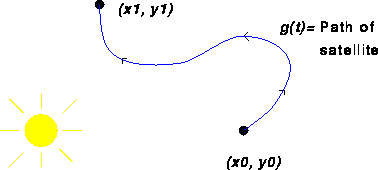The Definition of Work
For this lab, you will want to load some standard Maple packages:
with(plots): with(linalg):
In previous labs we defined a two-dimensional gravitational potential by:

Recall that F=-grad(P) is a (gradient) vector field representing the
gravitational force felt by a particle at point (x,y).
Notice that if a satellite starts close to the sun and we want to
move it farther away from the sun, then we must expend energy
(probably in the form of burning rocket fuel). We might expect that
the amount of energy we expend depends on the path that we use to to
move the satellite.
We say that the work done by F in moving the
satellite from (x0,y0) along the path parameterized by
g(t), 0< t < T is given by:

where g(0)=(x0,y0)and g(T)=(x1,y1). The work done by
us against F is -W.

Figure 1
Question #1
Explain in geometric terms:
- What does F(g(t)) represent?
- What does g'(t) represent?
- What does the dot product of F(g(t))
and g'(t) represent?
Question #2
For each of the following paths,
- Sketch the path.
- Compute the work done (that is, energy expended) against the
gravitational field in moving the
satellite along the path for
t=0..1.
- g(t) = [6+t,0]
- g(t) = [6*cos(2*Pi*t),6*sin(2*Pi*t)]
- g(t) = [t+6*cos(2*Pi*t),6*sin(2*Pi*t)]
We've provided some hints to help you get started.
Next: The Gradient Theorem
Previous: Introduction
Frederick J. Wicklin <fjw@geom.umn.edu>
Bob Thurman <thurman@geom.umn.edu>
Document Created: Mon Jan 9 1995
Last modified: Tue Apr 16 10:44:27 1996



